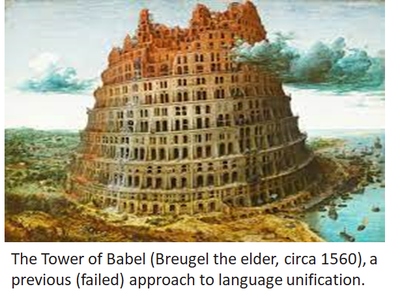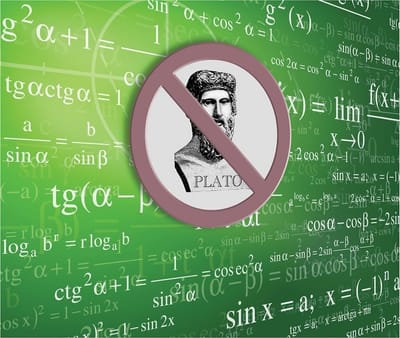Symbolic-Processor
A symbolic-processor (the Downloads web-page contains a proof-of-concept) is a putative new application-type that interprets SPL (symbolic-processing-language) and has been designed to enable this logic-chain:
Goal: A new, simple, single, & universal way of processing data (so commoditizing it)
Problem: A myriad of existing, competing and complex computer-languages
Solution: Extend the universal notation of arithmetic into computer-programming
Mechanism: Adopt the 4 principles below:
1. No Mathematical-Platonism
Traditional computer-languages, and indeed mathematics itself, use symbols to represent underlying objects that exist "out-there", such as integers, reals. bytes etc. These objects can then participate in various operations that again exist "out-there", such as addition, multiplication and concatenation etc.
Unlike this mathematical-Platonism, a symbolic-processor just processes symbols; no pretense is made of any underlying spooky "out-there" reality that they refer to; e.g. the statement abc + def is equally as valid as 123 + 456; it just returns a symbolic-string of zero length (nothing) as compared to the 3 symbol-string (579).
2. Spectral Data-Model
The spectral data-model maps symbolic-strings to physical data-structures and data-stores, whether these be in an application's fast-memory, an underlying file-system or database, on the web, etc. This allows a common way of maintaining data in any application, anywhere, whether it be a spreadsheet, a word-processor, an ERP system, accounting software, B2C retail, or whatever. The accompanying fractal tree-diagram (the pattern repeats itself in ever increasing granularity/resolution) represents the spectral data-model.
Data within a string has left-to-right asymmetry; leading symbols are more "well-known" and represent its key (the how-to-find) and are represented by colours towards the blue-end of the spectrum, while trailing symbols are less "well-known" and represent the record itself (the what-to-find) and are represented by colours towards the red-end of the spectrum.
The spectral data-model is implemented via 2 approaches. Firstly a thin processing layer is introduced at the application level to translate the local data-model (e.g. relational, file-system, spread-sheet etc.) into and out of the spectral data-model. Secondly data within the spectral model is held as a "Trie" data-structure. This data-structure has been optimized via "go-faster-striping" meta-data to deliver maximized performance (see the "Striped-Trie" web-page for details).
3. Combinatory Binary-Operations
With the exception of read-operations which utilize wild-cards and filters, all other operations in a symbolic-processor are binary; they have 1 operator, 2 input operands and 1 output, as in 1 + 2 which returns 3. These operations can be combined in various combinations across symbolic-strings to produce bijections and various Cartesian-products:
1 2 + 3 4 5 returns 1 5 4 5 (example standard)
1 2 ++ 3 4 5 returns 4 6 (example bijection)
1 2 +++ 3 4 5 returns 13 14 (example Cartesian-accumulate)
1 2 ++++ 3 4 5 returns 4 8 13 5 9 14 (example Cartesian-carry)
1 2 +++++ 3 4 5 returns 4 5 6 5 6 7 (example Cartesian-classic)
4. No Explicit Loops, Routines or If/Then Statements
The functionality above almost-entirely removes the need for a symbolic-processing-language to have explicit loops, routines or if/then statements. More fundamental operations (comparison and replication) can be used to provide this implicit functionality if required.
Details
For a detailed understanding there are downloads available on the Downloads web-page. These contain working examples, the computer code (MS VBA), and white-papers. In an example of determining the standard-deviation of a sample-set the number of lines-of-code is reduced from 25 in "C" to just 5 in SPL (symbolic-processing-language).
Goal: A new, simple, single, & universal way of processing data (so commoditizing it)
Problem: A myriad of existing, competing and complex computer-languages
Solution: Extend the universal notation of arithmetic into computer-programming
Mechanism: Adopt the 4 principles below:
1. No Mathematical-Platonism
Traditional computer-languages, and indeed mathematics itself, use symbols to represent underlying objects that exist "out-there", such as integers, reals. bytes etc. These objects can then participate in various operations that again exist "out-there", such as addition, multiplication and concatenation etc.
Unlike this mathematical-Platonism, a symbolic-processor just processes symbols; no pretense is made of any underlying spooky "out-there" reality that they refer to; e.g. the statement abc + def is equally as valid as 123 + 456; it just returns a symbolic-string of zero length (nothing) as compared to the 3 symbol-string (579).
2. Spectral Data-Model
The spectral data-model maps symbolic-strings to physical data-structures and data-stores, whether these be in an application's fast-memory, an underlying file-system or database, on the web, etc. This allows a common way of maintaining data in any application, anywhere, whether it be a spreadsheet, a word-processor, an ERP system, accounting software, B2C retail, or whatever. The accompanying fractal tree-diagram (the pattern repeats itself in ever increasing granularity/resolution) represents the spectral data-model.
Data within a string has left-to-right asymmetry; leading symbols are more "well-known" and represent its key (the how-to-find) and are represented by colours towards the blue-end of the spectrum, while trailing symbols are less "well-known" and represent the record itself (the what-to-find) and are represented by colours towards the red-end of the spectrum.
The spectral data-model is implemented via 2 approaches. Firstly a thin processing layer is introduced at the application level to translate the local data-model (e.g. relational, file-system, spread-sheet etc.) into and out of the spectral data-model. Secondly data within the spectral model is held as a "Trie" data-structure. This data-structure has been optimized via "go-faster-striping" meta-data to deliver maximized performance (see the "Striped-Trie" web-page for details).
3. Combinatory Binary-Operations
With the exception of read-operations which utilize wild-cards and filters, all other operations in a symbolic-processor are binary; they have 1 operator, 2 input operands and 1 output, as in 1 + 2 which returns 3. These operations can be combined in various combinations across symbolic-strings to produce bijections and various Cartesian-products:
1 2 + 3 4 5 returns 1 5 4 5 (example standard)
1 2 ++ 3 4 5 returns 4 6 (example bijection)
1 2 +++ 3 4 5 returns 13 14 (example Cartesian-accumulate)
1 2 ++++ 3 4 5 returns 4 8 13 5 9 14 (example Cartesian-carry)
1 2 +++++ 3 4 5 returns 4 5 6 5 6 7 (example Cartesian-classic)
4. No Explicit Loops, Routines or If/Then Statements
The functionality above almost-entirely removes the need for a symbolic-processing-language to have explicit loops, routines or if/then statements. More fundamental operations (comparison and replication) can be used to provide this implicit functionality if required.
Details
For a detailed understanding there are downloads available on the Downloads web-page. These contain working examples, the computer code (MS VBA), and white-papers. In an example of determining the standard-deviation of a sample-set the number of lines-of-code is reduced from 25 in "C" to just 5 in SPL (symbolic-processing-language).

